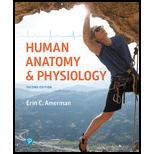
Which of the following best describes the basic function of the autonomic nervous system?
a. Controls the somatic nervous system
b. Controls automatic functions to maintain homeostasis
c. Detects somatic sensory information
d. All of the above
Introduction:
The nervous system is a network of nerves and cellsthat connects body parts to the brain and the spinal cord of humans. It is divided into two parts, which are the central nervous system (CNS) and peripheral nervous system (PNS). This PNS is further divided into the autonomic nervous system (ANS)and the somatic nervous system.
Answer to Problem 1CYR
Correct answer:
b. Controls automatic functions to maintain homeostasis.
Explanation of Solution
Justification/explanation for the correct answer:
Option (b) is given that control automatic functions to maintain homeostasis. The ANS controls the heart rate, blood pressure, digestive system, and urinary systems. These are all involuntary functions and are automatically regulated. The organs are regulated by visceral reflex arcs. All these processes are done in order to maintain homeostasis. Hence, option (b) is correct.
The explanation for the incorrect answer:
Option (a) is given that controls the somatic nervous system. The ANSdoes not control the somatic nervous system. The ANShelps in controlling involuntary actions whereas the somatic nervous system controls the voluntary actions in the human body. So, it is an incorrect option.
Option (c) is given that detects somatic sensory information. The somatic sensory information is of voluntary actions. The ANScontrols the involuntary actions of the human body. So, it is an incorrect option.
Option (d) is given that all of the above. The autonomic nervous system, or ANS, helps in controlling the automatic functions of the body so that homeostasis could be maintained. The rest of the functions, like detecting the somatic sensory information and controlling the somatic nervous system, are not associated with ANS. So, it is an incorrect option.
Hence, options (a), (c), and (d) are incorrect.
Thus, it can be concluded that the ANSis one of the parts of the PNS. It controls the involuntary actions of the human body, such asblood pressure, heart rate, urinary systems, and the digestive system. The organs are regulated by the visceral reflex arcs and to maintain homeostasis.
Want to see more full solutions like this?
Chapter 14 Solutions
Human Anatomy & Physiology Plus Mastering A&P with Pearson eText -- Access Card Package (2nd Edition) (What's New in Anatomy & Physiology)
- State the five functions of Globular Proteins, and give an example of a protein for each function.arrow_forwardDiagram of check cell under low power and high powerarrow_forwarda couple in which the father has the a blood type and the mother has the o blood type produce an offspring with the o blood type, how does this happen? how could two functionally O parents produce an offspring that has the a blood type?arrow_forward
- What is the opening indicated by the pointer? (leaf x.s.) stomate guard cell lenticel intercellular space none of thesearrow_forwardIdentify the indicated tissue? (stem x.s.) parenchyma collenchyma sclerenchyma ○ xylem ○ phloem none of thesearrow_forwardWhere did this structure originate from? (Salix branch root) epidermis cortex endodermis pericycle vascular cylinderarrow_forward
- Identify the indicated tissue. (Tilia stem x.s.) parenchyma collenchyma sclerenchyma xylem phloem none of thesearrow_forwardIdentify the indicated structure. (Cucurbita stem l.s.) pit lenticel stomate tendril none of thesearrow_forwardIdentify the specific cell? (Zebrina leaf peel) vessel element sieve element companion cell tracheid guard cell subsidiary cell none of thesearrow_forward
- What type of cells flank the opening on either side? (leaf x.s.) vessel elements sieve elements companion cells tracheids guard cells none of thesearrow_forwardWhat specific cell is indicated. (Cucurbita stem I.s.) vessel element sieve element O companion cell tracheid guard cell none of thesearrow_forwardWhat specific cell is indicated? (Aristolochia stem x.s.) vessel element sieve element ○ companion cell O O O O O tracheid O guard cell none of thesearrow_forward
 Comprehensive Medical Assisting: Administrative a...NursingISBN:9781305964792Author:Wilburta Q. Lindh, Carol D. Tamparo, Barbara M. Dahl, Julie Morris, Cindy CorreaPublisher:Cengage Learning
Comprehensive Medical Assisting: Administrative a...NursingISBN:9781305964792Author:Wilburta Q. Lindh, Carol D. Tamparo, Barbara M. Dahl, Julie Morris, Cindy CorreaPublisher:Cengage Learning Medical Terminology for Health Professions, Spira...Health & NutritionISBN:9781305634350Author:Ann Ehrlich, Carol L. Schroeder, Laura Ehrlich, Katrina A. SchroederPublisher:Cengage Learning
Medical Terminology for Health Professions, Spira...Health & NutritionISBN:9781305634350Author:Ann Ehrlich, Carol L. Schroeder, Laura Ehrlich, Katrina A. SchroederPublisher:Cengage Learning Concepts of BiologyBiologyISBN:9781938168116Author:Samantha Fowler, Rebecca Roush, James WisePublisher:OpenStax College
Concepts of BiologyBiologyISBN:9781938168116Author:Samantha Fowler, Rebecca Roush, James WisePublisher:OpenStax College Human Physiology: From Cells to Systems (MindTap ...BiologyISBN:9781285866932Author:Lauralee SherwoodPublisher:Cengage Learning
Human Physiology: From Cells to Systems (MindTap ...BiologyISBN:9781285866932Author:Lauralee SherwoodPublisher:Cengage Learning





